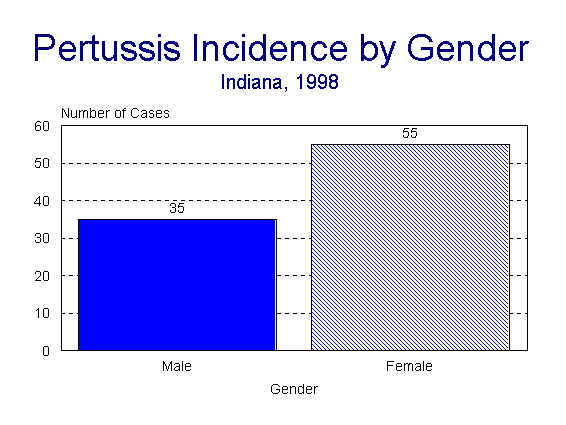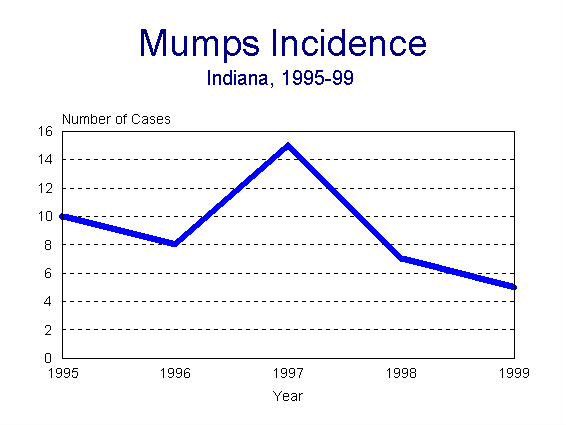
Vaccine-Preventable Diseases
In 1994, the Indiana State Department of Health set goals for the elimination of measles, rubella, polio, diphtheria, and tetanus in persons under the age of fifteen, and invasive Haemophilus influenzae type b disease in children under the age of five. For each of these diseases, in at least one-year since 1994, the target of zero cases has been achieved. Appendix I depicts the number of cases for selected childhood vaccine-preventable diseases from 1949 through 1999. In 1999, the target of zero was reached for diphtheria and polio. Indiana established a goal of no more than ten cases of mumps in 1999, which was also attained. A specific goal for pertussis has not been established. The following narrative describes childhood vaccine-preventable disease morbidity for 1999.
Cases
= 90Crude Rate
(per 100,000) = 1.53Ninety (90) cases of pertussis occurred in Indiana during 1999. Twenty-nine counties reported at least one case of pertussis during the year (see Figure 1), with Hamilton County having 22 cases, the highest number for any county in the state.
Figure 1. Pertussis Cases by County - 1999

Of the 41 cases in infants less than two years of age, 32 (78%) were hospitalized. This compares with only one of forty-nine cases (2%) over two years of age being hospitalized. Twenty-four cases (26.6%) were culture confirmed with another 2 (2.2%) being positive by PCR analysis. Thirty-nine (43.3%) of the cases were less than one year of age and 17 (18.8%) cases were 20 years or older (see Figure 2 for complete age group breakdown).
Figure 2.
Table 1 depicts the vaccination status of cases ages 3 months to 6 years (n=26). An infant should receive their first dose of vaccine before the third month of life. There were 27 cases less than 3 months of age.
Table 1.
Vaccination Status of Cases Ages 3 Months to 6 Years (n=26)
|
AGE |
Minimum Number Doses Recommended |
Number Vaccinated |
Percent Vaccinated |
|
3-4mo |
1+ |
5 / 9 |
56% |
|
5-6mo |
2+ |
0 / 0 |
-- |
|
7-18mo |
3+ |
2 / 5 |
40% |
|
19mo-4yrs |
4+ |
8 / 12 |
67% |
|
5-6yrs |
4+ |
0 / 0 |
-- |
|
Total |
|
15 / 26 |
65% |
Although pertussis incidence in 1999 was down from the 185 cases in 1998, a gradual increase during the 1990s can be noted in Figure 3. The five-year mean for the past five years was 117 (1995-99) and 110 for the five previous years (1990-94). The mean number of cases for 1980-89 was 108 cases. Incomplete vaccine coverage is only one reason that pertussis continues in unacceptable numbers. Infants may become infected by adolescents and adults, whose immunity to pertussis may have waned. Currently, pertussis vaccine is only available for children less than seven years of age. The research community continues to develop a vaccine that is safe and effective for those age seven years and older, which will aid in the reduction of pertussis incidence in older age groups.
Figure 3.

Figure 4.

Cases
= 2Two unrelated cases of measles were serologically confirmed in Indiana during 1999, both being a result of international importation. Each case of measles occurring in Indiana since 1994 has been due to international importation. Limited transmission from the two 1999 cases and other international importations in the United States demonstrates the success of vaccination efforts in Indiana and the nation. According to 1998 CDC National Immunization Survey, one dose measles vaccine coverage rates for children 19-35 months of age was 92.9% in Indiana and 92.1% in the U.S. For Indiana children in the sixth grade and above, two-dose coverage has been consistently above 98% since the requirement was implemented in 1991. Measles cases have continued at low levels (Figure 5), since the two-dose requirement for sixth graders and other vaccination efforts aimed at preschool children were implemented in the early 1990s. Since 1990, there have been three years with no cases being reported, and in two other years, only 1 case was reported.
Figure 5.
Haemophilus Influenzae Type b (Invasive)
Cases
= 3 (two cases less than five years of age)Three cases of invasive Haemophilus influenzae type b were reported in 1999, two of which were in children less than five years of age. The other case was a 70 year-old patient. One other case of invasive Haemophilus influenzae disease was reported in a child less than five years of age, but serotype information was not obtained. Prior to the licensure of Hib vaccine, Haemophilus influenzae type b disease was the leading cause of bacterial meningitis in children. Since the introduction of Hib vaccine in the late 1980s, the incidence of invasive Hib disease has decreased dramatically in children. The mean number of cases the past five years is 2.0 per year (Figure 6). In 1999, twenty-four cases of invasive Haemophilus influenzae disease were reported in all age groups with 20 (83.3%) being serotyped. Efforts must continue to ensure that all invasive Haemophilus influenzae isolates be serotyped to determine if type b illness is present.
Figure 6.
Cases
= 5Mumps incidence remains at record low levels in the state with only five cases being confirmed in 1999. This is the lowest number of cases ever recorded in Indiana. The highest number of cases in the past five years was 15 in 1997, as depicted in the five-year line graph (Figure 7). Of the five cases occurring in 1999, all were eligible for vaccination. Two had no vaccine history, two had one dose of mumps vaccine, and the other case had two doses. Three of the cases were female, two were male, and all five were of the white race. All five cases were laboratory confirmed.
Figure 7.

Cases
= 1One case of rubella, the first since 1993 was laboratory confirmed in a 24 year-old white Hispanic male in Elkhart County. Extensive surveillance in the county revealed no spread from this case.
Cases
= 0The last case of vaccine associated paralytic poliomyelitis in Indiana was confirmed in 1998.
Cases
= 1One case of tetanus occurred in a four year old unvaccinated male. This is the first case of tetanus in a person under the age of 15 in recent history. The child survived after being hospitalized for 26 days.
Cases
= 0The last case of diphtheria to occur in Indiana was in 1996. The last case before 1996 was confirmed in 1970.
[an error occurred while processing this directive]